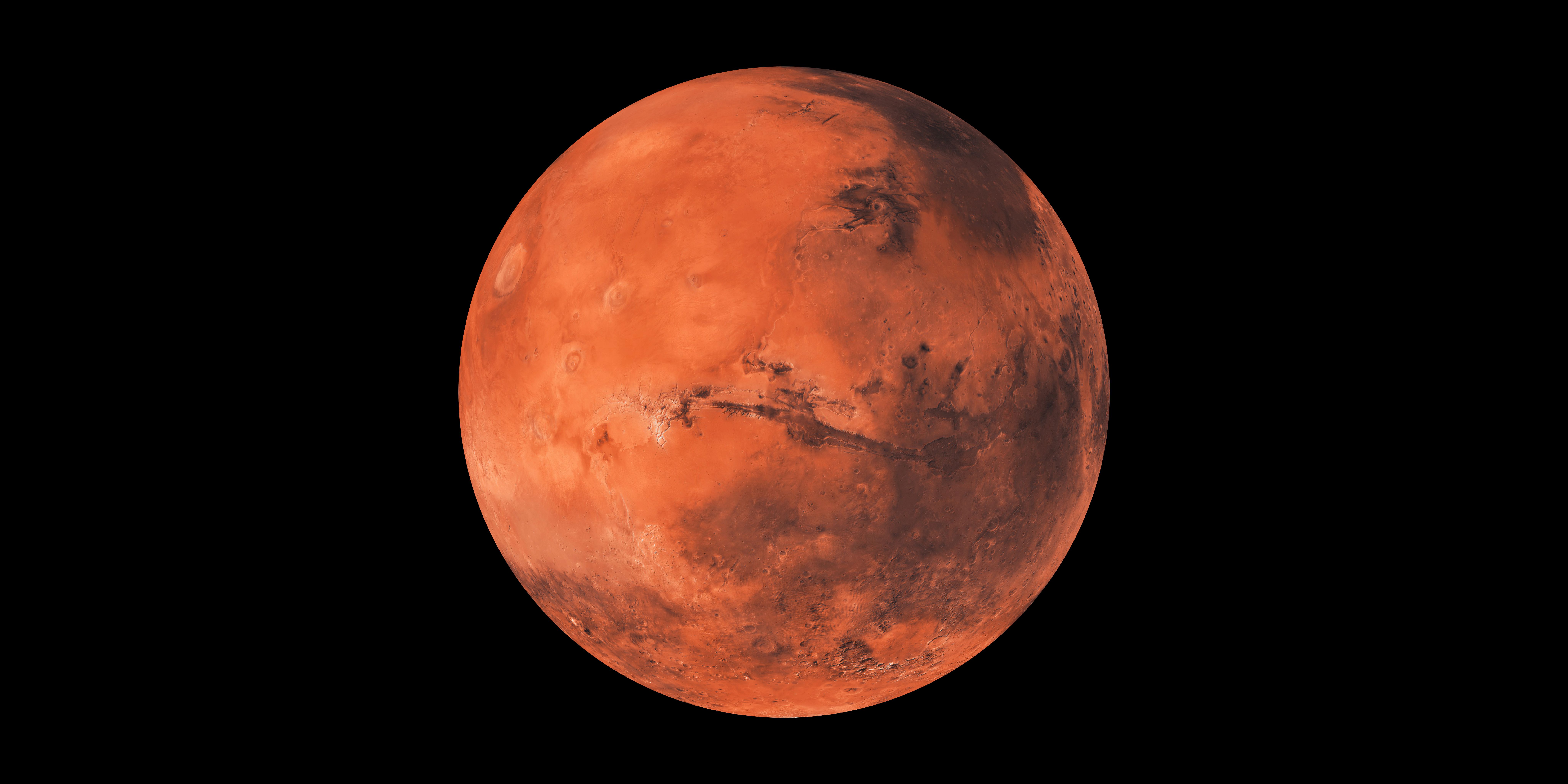An Inside Look at the Raman and Infrared Spectral Signatures of Carbonates, Phosphates, and Sulfates
A recent study revealed new insights into the effects of ultraviolet (UV) radiation on Martian minerals.
According to a recent study published in Icarus, researchers can determine how exposure to ultraviolet (UV) radiation on Martian minerals influences the spectral signatures of carbonates, phosphates, and sulfates.
The surface of Mars is subjected to constant bombardment by ionizing and non-ionizing radiation, including UV radiation, which poses a potential challenge for the identification of hydrated minerals such as sulfates, phosphates, and carbonates (1). These minerals are crucial for deciphering the planet's past environmental conditions and potential habitability (1). In their study, the research team investigated how exposure to UV radiation within a Martian-like environment affects the spectral signatures of carbonates, phosphates, and sulfates.
Mars red planet black background | Image Credit: © Martin - stock.adobe.com

The lead authors of the study, C. Royer and S. Bernard, conducted their experiments by using a Martian chamber that replicated Mars’s temperature and atmospheric conditions. They exposed pellets of varying hydration levels of sulfates, phosphates, and carbonates to UV radiation and then analyzed the resulting changes in their Raman and infrared (IR) signals (1).
What they found was that the UV exposure led to a significant alteration in the Raman and IR signals of the studied minerals. There was a strong increase in luminescence signals coupled with a decrease in Raman signals relative to the background (1). Additionally, there was a clear attenuation of IR signals. These changes were attributed to an increased concentration of electronic defects within the minerals caused by UV radiation (1).
This discovery is particularly relevant for NASA's Perseverance rover, which is tasked with collecting samples that may one day be returned to Earth for detailed analysis (1–3). The study suggests that all targets measured or collected on Mars should be considered as having been exposed to UV radiation to some extent (1). This means that the data collected by Perseverance must be interpreted with caution because the potential alterations caused by UV exposure must be taken account.
The research also highlights the importance of using multiple analytical techniques to study Martian samples. The combination of Raman and IR spectroscopy, along with other methods, can provide a more comprehensive understanding of the mineralogical changes induced by UV radiation (1).
The study by Royer and Bernard is a significant step forward in our understanding of Martian geology and the challenges posed by the planet's harsh environment. The pervasive influence of UV radiation on the planet's surface means that researchers must account for potential alterations in their analyses. This study not only reveals the complexities of Martian exploration, but it also paves the way for more informed and accurate scientific investigations of the Red Planet.
As Perseverance continues its mission on Mars, the insights provided by this study will play a crucial role in shaping our understanding of the planet's past and its potential for harboring life. The ongoing exploration of Mars remains one of the most exciting frontiers in planetary science, and studies like this bring us one step closer to unraveling the mysteries of Mars, which will be influential in moving forward as we seek to send astronauts to the planet in the future.
Learn More: The Possibilities of Humans on Mars
References
(1) Royer, C.; Bernard, S.; Beyssac, O.; et al. Impact of UV Radiation on the Raman and Infrared Spectral Signatures of Sulfates, Phosphates and Carbonates: Implications for Mars Exploration. Icarus 2024, 410, 115894. DOI: 10.1016/j.icarus.2023.115894
(2) Workman, Jr., J. Mars Rover Uses Spectroscopy to Detect Diverse Organic-Mineral Associations in Jezero Crater. Spectroscopy. Available at: https://www.spectroscopyonline.com/view/mars-rover-uses-spectroscopy-to-detect-diverse-organic-mineral-associations-in-jezero-crater (accessed 2024-07-09).
(3) Wetzel, W. Raman Spectroscopy and its Role in Perseverance Rover’s SuperCam Instrument. Spectroscopy. Available at: https://www.spectroscopyonline.com/view/raman-spectroscopy-and-its-role-in-perseverance-rover-s-supercam-instrument (accessed 2024-07-09).
AI-Powered SERS Spectroscopy Breakthrough Boosts Safety of Medicinal Food Products
April 16th 2025A new deep learning-enhanced spectroscopic platform—SERSome—developed by researchers in China and Finland, identifies medicinal and edible homologs (MEHs) with 98% accuracy. This innovation could revolutionize safety and quality control in the growing MEH market.
New Raman Spectroscopy Method Enhances Real-Time Monitoring Across Fermentation Processes
April 15th 2025Researchers at Delft University of Technology have developed a novel method using single compound spectra to enhance the transferability and accuracy of Raman spectroscopy models for real-time fermentation monitoring.